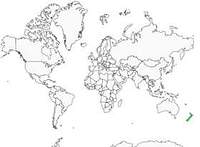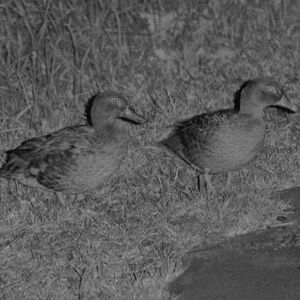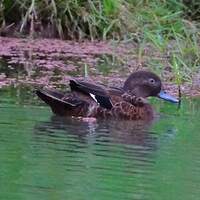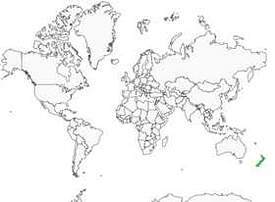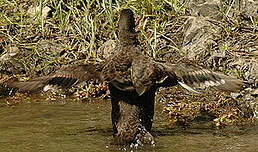Brown Teal
Anas chlorotis - Sarcelle de Nouvelle-Zélande
Identification
Brown Teal have a generally dark appearance. Males in breeding plumage have a glossy green head, rufous-brown flanks and chest, and brown upperparts. They have a white patch at the rear of their bodies and a very thin white collar which may not be visible. Females, young, and eclipse males are a warm brown colour, almost uniform. The bill is blue. In flight there is a large, barely framed, green mirror. The species is distinguished from the Brown Teal, Anas castanea, by its white eye-ring. The Brown Teal has a wide white patch above the green mirror in flight. Birds living on the two main islands (Anas chlorotis) have recently been separated from those living in the Auckland Islands (Anas aucklandica) and Campbell Islands (Anas nesiotis). Individuals found in these islands do not fly. This is not the case for 'chlorotis', although we have never seen it flying.
Subspecific information monotypic species
Foreign names
- Sarcelle de Nouvelle-Zélande,
- Cerceta maorí,
- marrequinha-maori,
- Neuseelandente,
- Bruine Taling,
- Alzavola bruna,
- brunkricka,
- Kobberand,
- kačica hnedá,
- čírka novozélandská,
- Newzealandsk Brunand,
- ruskotavi,
- xarxet de Nova Zelanda,
- cyraneczka rdzawa,
- Бурый чирок,
- チャイロコガモ,
- 褐鸭,
- 棕腹鴨,
Voice song and call
Habitat
The Brown Teal is an endemic species of New Zealand. It can be found in the extreme south of Fiordland (southwest of the south island) as well as in a few points on the north island.
Behaviour character trait
The Brown Teal of New Zealand is very tame which has probably been to its detriment. It is mainly nocturnal and is mostly encountered in couples or family groups, never in large flocks. Couples seem to stay together for life. Both the male and female stay together all year round. During the breeding season, Brown Teal of New Zealand defend a territory. In my opinion, for the majority of couples this must not be a substantial issue, because there are few that have close neighbours!
Flight
Dietfeeding habits
Reproduction nesting
The Brown Teal, a bird from the antipodes, has a breeding season in reverse to ducks in our hemisphere, spanning July to December. The nest is a well-concealed cup of grass under bushes close to water, and the female usually lays 6 eggs. During this period, the birds are only active at night. They spend the day under the surrounding vegetation.
Threats - protection
IUCN conservation status
concern
in the Wild
threatened
evaluated
The Brown Teal of New Zealand is classified as 'endangered' by BirdLife International. At the beginning of the 21st century, the population of wild birds did not exceed 1500 individuals. There are also a few dozen birds raised in captivity in order to create a captive population which would allow for the reintroduction of Brown Teal into the wild. Unfortunately, all attempts at re-introduction have failed (a thousand birds were released to no avail!). The main cause of the drastic decrease in population is the introduction by the European colonists of several species of predatory mammals (mustelids and brushtail possums from Australia). Cats and dogs are also formidable predators. On the other hand, although the species has been protected since 1921, it seems that poaching exists in certain sites. New Zealand ornithologists and conservationists are anything but optimistic and think the populations living on the two main islands are doomed to extinction, even though thanks to continuous control of the predators, some local successes have been recorded. Fortunately, the largest part of the population is living on the island of the Great Barrier, way off in the Hauraki Gulf. It does not seem that the populations introduced on a few predator-free islands are viable as they are too small.
Sources of information
- IOC World Bird List (v14.2), Gill, F and D Donsker (Eds). 2024-04-18.
Other sources of interest
 Specification sheet created on
01/08/2023 by Georges Olioso
Specification sheet created on
01/08/2023 by Georges OliosoTranslation by AI Oiseaux.net
© 1996-2025 Oiseaux.net
- Accipitriformes
- Aegotheliformes
- Anseriformes
- Apodiformes
- Apterygiformes
- Bucerotiformes
- Caprimulgiformes
- Cariamiformes
- Casuariiformes
- Charadriiformes
- Ciconiiformes
- Coliiformes
- Columbiformes
- Coraciiformes
- Cuculiformes
- Eurypygiformes
- Falconiformes
- Galliformes
- Gaviiformes
- Gruiformes
- Leptosomiformes
- Mesitornithiformes
- Musophagiformes
- Nyctibiiformes
- Opisthocomiformes
- Otidiformes
- Passeriformes
- Pelecaniformes
- Phaethontiformes
- Phoenicopteriformes
- Piciformes
- Podargiformes
- Podicipediformes
- Procellariiformes
- Psittaciformes
- Pterocliformes
- Rheiformes
- Sphenisciformes
- Steatornithiformes
- Strigiformes
- Struthioniformes
- Suliformes
- Tinamiformes
- Trogoniformes


